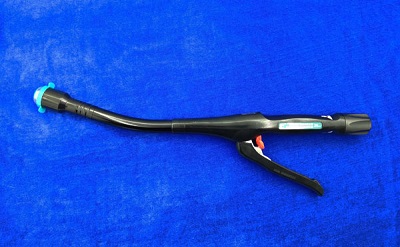Stapling, also known as stitching machine, since the products have been developed and has been used for surgical suture, from the early used in gastrointestinal surgery, by now been used in many clinical surgery, and stapling products, also obtained fast development, we have the digestive tract known stapling stapling, linear cutting anastomat, circular cutting anastomat and tube stapling and so on.
Compared with traditional surgical suture, suture by anastomosis is more convenient and simpler, and the stitches are more neat. For many patients, the neat surgical suture will make the patients feel more relaxed and comfortable.
The following focuses on the introduction of tubular stapler.
Tubular stapler features:
Strictly speaking, the stapler basically used for all kinds of cavity anastomosis is called tubular stapler.
The reason why tubular stapler is called tubular stapler is that when it comes in and out of the tissue, it will form two rows of circular arrangement interlaced stitches, and then cut off the inner tissue with a ring knife, which can achieve rapid and simple anastomosis for tubular organs.
In a word, tubular staplers are mainly used for anastomosis of tubular organs. Different staplers are suitable for different operations. For example, 21, 23, 26 and 29 are mostly used for esophagus and small intestine operations, and 32 and 34 are mostly used for colon and rectum operations.

Use of tubular stapler:
1. Select the appropriate stapler;
2. Rotate the adjusting nut counterclockwise to open the locking seat and take out the protective cover until the locking seat is completely opened;
3. Rotate the adjustable knob counterclockwise until you see the red knot area of the built-in puncture device, then pull out the nail seat and rotate the adjustable knob clockwise, so that the built-in puncture device can be fully incorporated into the body of the stapler;
4. Place the removed nail holder into one end of the tubule for anastomosis that has been pocketed for suture, tighten the purse risk at the knotted groove of the nail holder, and trim the excess tissue edge;
5. Place the stapler into the other end of the cavity to be anastomosed, and rotate the adjustable knob counterclockwise to make the head of the stapler inside break through the closed cavity until the red knotted area at the back of the puncture device can be clearly seen;
6. Set the top anvil head of the stapler and push it inward until the sound of "click" is heard, then the stapler is aligned, the tissue tube is adjusted and the stapler is closed.
7. Tighten the stapler until the stapler instruction window jumps;
8. Confirm whether the stapler is in place;
9. Exit the stapler body while rotating;
10. Confirm whether the excised tissue is intact and whether there is any abnormality at the suture site. If any abnormality is found, it should be handled in time.
Post time: Jan-07-2022





